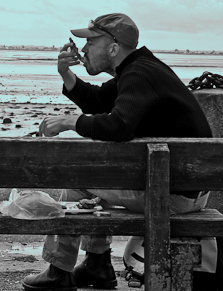Joe Ray
Food & Travel / Words & Photos

Monday, March 16, 2009
Bubbly Basics
I wheedled my way into a Krug Champagne tasting in Barcelona the other day – my birthday no less! - getting a chance to sip on some pretty fancy stuff.
I can’t say buying a bottle of their bubbly is the first thing I’d do with a few extra c-notes, but I liked LVMH (Krug’s parent company) enologist Xavier Montclús’ back-to-basics, grapes-to-glass approach to the tasting, even in a room full of food-industry pros that included sommeliers and Michelin-starred chefs.
A few highlights:
THE GRAPES:
Montclús’ metaphors to understand part of each grape’s role in Champagne…
Pinot Noir – “The backbone and the muscles that hold up the wine†– anti-flab, if you will.
Pinot Meunier – “The bones which give fruit flavors like pear, peach and quince…remember that the best taste in meat is closest to the bone.â€
Chardonnay – “The skin.†The skin? Eww. “Like on a peach. It contributes smell (honey, for one)
and golden color.†Mmm.
PRESENTATION:
- The Cork - “Loosen the cage that holds the cork, but keep it on top of the bottle, with your hand on it at all times,†he says, reminding me of a moment when I was a waiter on a San Francisco Bay dinner cruise (dressed like Gopher from “The Love Boat,†no less) and put a quarter-inch dent in a ceiling tile with a cork before beaning a woman on the top of her head. Hoo, dear, I couldn’t stop laughing. “Hold the cage & cork in one hand and turn the bottle with the other.â€
- The Bucket – “Fill it three-quarters of the way with ice, then halfway up with water.†A bottle that hasn’t been cooled should be kept on ice ½ hour, but not more. “Minimum temperature should be five degrees Celsius (41 F) – lower than that just brings out the defects.â€
- The Pour – “Never serve more than half a flute.â€
Bottoms up!
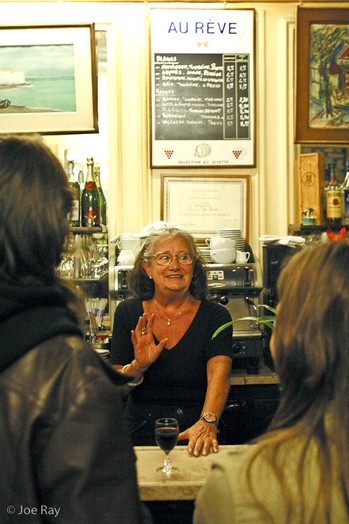
Monday, March 09, 2009
Fair vins and following seas
Bad news, bar fans!
Even in Barcelona, word got to me that after decades of running one of my favorite spots for a Paris apéro, Elyette Planchon has hung up her high heels and sold Au Reve, her 18th arrondissement landmark bar, and retired. For the returning traveler, Elyette and Au Reve were the perfect way to feel back at home in the City of Light.
Not for lack of trying, but one of my biggest food regrets in Paris is never having had one of her semi-secret Wednesday lunches.
Sniff!
Instead of crying in my beer, let’s raise a glass of wine to Elyette, wish her well and do as it said on her apron – la geste qui sauve les vignerons* – take a sip.
* “The gesture that saves winemakersâ€
Click here to see my Boston Globe Travel article, “Paris dreams of things to come – after an apéro†which features Elyette and Au Reve
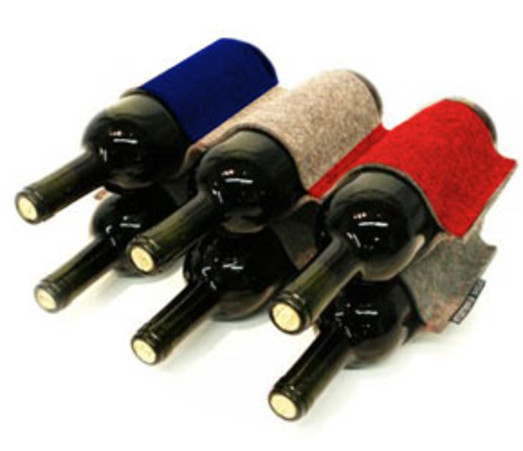
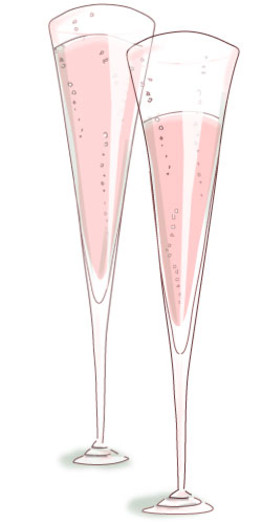
Saturday, December 13, 2008
Stories for Wine Lovers
Good news for wine lovers! A pair of my recent articles about French winemakers is now on brandchannel.com.
“Is ‘Made in France’ Enough?†mulls the debate of whether France should take the high road on the export market or push out plonk.
“Brands are supported by marketing and other countries spend a lot more on it. Here, with government restrictions on advertising, you can’t concentrate on it much and, abroad, we’re useless. We were passed,” says ‘flying winemaker’ Stephane Derenoncourt. Hidden in his bleak outlook for French wine brands, however, is what many consider to be the solution… READ ON.
Just in time to ring in the new year, “De-vine Intervention†interviews two top guns at Louis Roederer Champagne on the pros and cons of using art and artists – whether you want to or not – to promote a brand…and what to do when it all goes wrong… READ ON.
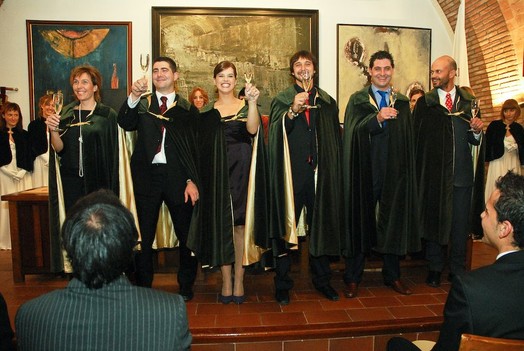
Wednesday, November 19, 2008
Call Me ‘Sir’???
Blame it on sloth or modesty, but I haven’t done much in the self-promo department lately.
Credit a bump in motivation or a lack of scruples for rectifying that problem posthaste.
First and most exciting, I’m a knight! Technically, I’m a young knight of the Confraria del Cava – the brotherhood of Cava, Catalonia’s sparkling wine – thanks to a series of articles that I wrote about the bubbly a few years back.
On October 11, in Sant Sadurnà d’Anoia, Spain, I donned a heavy green cape, made an oath in Catalan(!) pledging my allegiance to Cava, chugged a glass, was tapped with a sword on each shoulder and officially became a knight. I was one of six knights of merit (the Spanish Olympic men’s field hockey team was sworn in as knights of honor), and as far as I could tell, the only foreigner in the room and one of the first non-Catalans in the Confraria’s history to be inducted. Quite flattering.
Earlier this month, I was ask to host a round table discussion at the American Library in Paris around the theme ‘Is French Cuisine Worthy of UNESCO Heritage Status.’ We had fantastic panelists - Clotilde Dusoulier, author of ‘Chocolate & Zucchini’ and ‘Clotilde’s Edible Adventures in Paris,’ (and former interviewee of mine!), Charlotte Puckette and Olivia Kiang-Snaije, co-authors of ‘The Ethnic Paris Cookbook,’ and, to spice things up a little, Catalan journalist and sommelier and author of the blog Wines and The City, Meritxell Falgueras. Great subject, perfect panelists and a full house!
Finally, I’ve made a huge update to my Web site, adding published stories and photos from South America, Sicily, Scotland and Paris – feel free to check them out at http://www.joe-ray.com. Please send me an email here if you’d like to be placed on the mailing list that goes out when a group of new stories go online.
More to come, including stories and blogs from France, Barcelona, Lisbon and Algeria… stay tuned.
Photo: courtesy Confraria del Cava
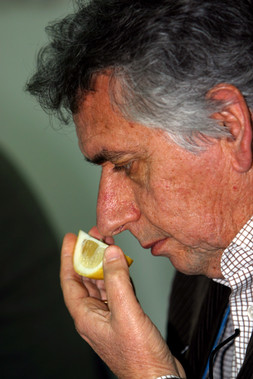
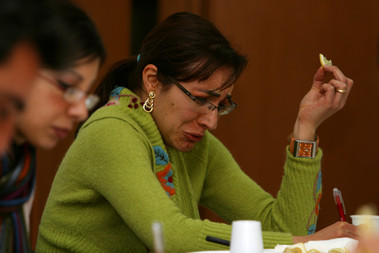
Friday, February 16, 2007
Sucking Lemons with the Pros
Here in southern Sicily, lemon and orange groves seem to line every road, but the idea of a lemon tasting I was invited to sounded rather masochistic. It made me think of a puckered-up version of that old National Geographic picture with the line of women in lab coats sniffing men’s underarms.
Plus, a lemon’s a lemon, right?
Not so, thinks Dr. Giuseppe Cicero who works for Italy as a sensorial analyst and food-quality controller.
Cicero’s lemon tasting directly followed a tasting of renowned Modican chocolate and the two couldn’t have elicited more different reactions. He wheeled several hospital carts’ worth of lemons on numbered plastic plates out to his tasters. These local food professionals taste with Cicero weekly. They clearly enjoyed the chocolate, but their bodies were definitely at odds with the idea of straight lemon.
Far from the physical restraint normally seen at wine tastings, here the tasters recoiled, puckered, shuddered, occasionally giggled, and generally tended to look like they were having way less fun than they did with the chocolate.
Clearly, they were pushing themselves toward their task for the good of humanity. But what good?
“We’re looking for both common characteristics and what differentiates them,” said Cicero. “Tomatoes and carrots come from the earth and they speak of the earth. They have a primal link to their territory. We want to transfer these sensations to the people who eat them.”
In wine terms, he sounded like a sommelier who was trying to make a bottle sound better than it was, so I asked for my own plates of lemons.
Like his tasters, I had trouble pulling a plate full of lemons toward me, but then a funny thing happened.
On a good day, when I poke my nose in a glass of wine, I can pick out a few key elements; something really good will actually give me goose bumps or a flicker of emotion.
Here, the smell of lemons, of all things, triggered memories and feelings, and each type of lemon brought something different.
I tasted them, and puckered and shuddered like everyone else in the room, but, without really thinking about it, how each lemon should be used in cooking came to me, no question - clear as day. One was for vinaigrette, another, with a deeper flavor, for broiled scallops, the third was made to go in seltzer water or to flavor desserts, and number four was made for…squid.
If only wine pairings came to me this easily.
I tell Cicero all this and he blames man.
“Winemaking has a huge amount of human intervention and these [lemons and other fruits and vegetables] have none. It’s a direct link to the elements of the tree and around it.”
“We’re trying to get people to think of the importance of what they put in their mouths,” he said. “We want them to say, ‘This comes from my land.’”
Speak of the earth, indeed
This is Joe Ray reporting from the Motherland.
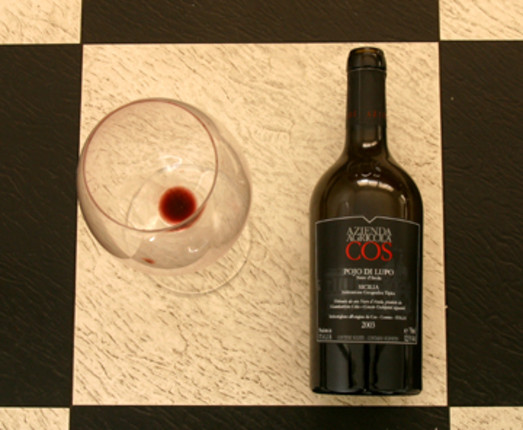
Wednesday, February 07, 2007
Rock & Avola in The Motherland
We have been threatening to seriously taste some wines together since I got here. Tonight, we made good on the promise and I got a sort of Sicilian wine primer as a bonus.
I grabbed the wine from its display space next to its empty cousins on my kitchen floor and stole some big, beautiful tasting glasses from an undisclosed location. To keep the babes of Ispica at bay, we tasted in the office.
I put on some Green Day and Visqueen and we dove in.
The wine was a 2003 “Pojo di Lupo” – made entirely of one of Sicily’s best known grapes, the Nero d’Avola (Black from Avola), from the COS vineyard in the nearby town of Comiso.
We discuss the color – I say “ruby with a brown edge,” and F. says “pomegranate.”
“Is that ‘grenade?’” (like the French), I ask.
“Do you mean in Italian or Sicilan?” he replies.
“Either.”
“No.”
“Nero d’Avola is a grape that’s historically important to Sicily and in the last few years, has become trendy [in other parts of Sicily],” he explained. This latter part raises the hackles of the people in this neck of the woods, as they’d like to see it come from somewhere closer to Avola. Typically, this means towns within a tight radius – Ispica, at about 15 miles from Avola makes the cut, but Comiso, at 30, starts raising eyebrows.
Then again, Avola is the town with an Eiffel Tower replica next to a lit up jet fighter at a bend in the road.
The grape’s newfound popularity is a double-edged sword: Sicily finally gets some well-deserved recognition for making a great wine, but it also means that the number of morons out there making bad wine with good grapes increases.
The nose is where things got interesting.
In a tasting, I can usually tell when I’ve left France, but here things were very different.
“When you go from France to Sicily, it’s like going to Mars,” said F.
This certainly felt like an alien landscape, but a half hour of swirling and smelling before we took a sip began to bear fruit: for me, this wine had a smell of marinated cherries, then something that seemed to me to be mint or menthol that F. pegged as a woody balsamic smell. The last smell was the hardest to peg – somewhere between tea (it reminded me of mom’s Red Rose) and tobacco, the latter turning out to be one of the typical undertones in a Nero d’Avola. Woohoo! For someone like me who gets excited when I can pick one key element out of a wine when I’m really trying, getting three was exciting in a food geek kind of way.
In the mouth it tasted exactly like it smelled – how’s that for well-balanced?
This isn’t always the case, and it turned out to be one of the peculiarities of this producer’s version of the wine, for better and for worse. Nero d’Avola tends to be huge, and the producers reigned it in so much that the tobacco stood out and the big berry tastes that are its hallmarks didn’t even show up until we had the bottle open for a couple of hours.
That said, we finished the bottle; with wine that tends to be huge and full of alcohol (products of the Sicilian sun), you’re either ready to go to bed or chase Sicilian women after a glass or two.
At the end of the night, we switched music to some of F’s favorites - Gerry Mulligan, Steely Dan, and David Bowie doing a curious Beatles cover. Then Frank Sinatra came on and F. grinned, smiled, whistled and tapped his feet.
Which is exactly what should happen when you’re enjoying what you drink.
This is Joe Ray reporting from the motherland.
